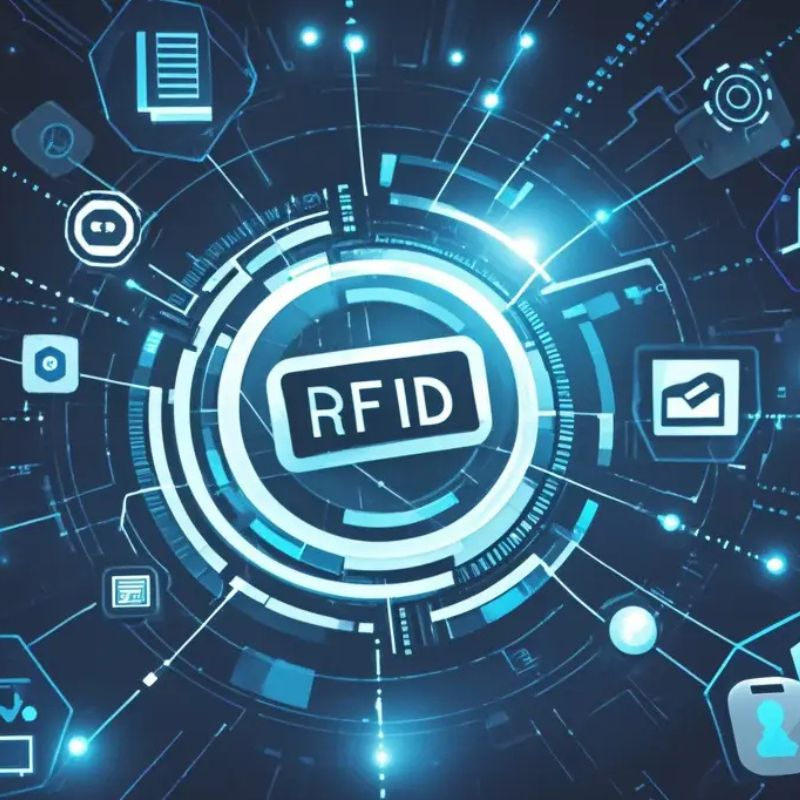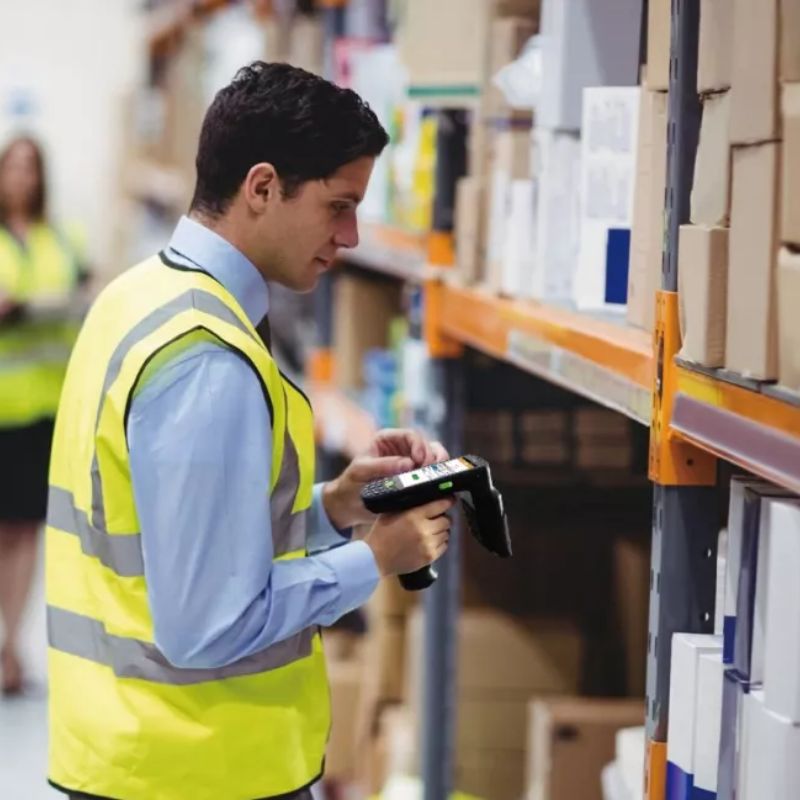
Understanding RFID What is Radio Frequency Identification and How It Works
Table of Contents
How RFID Radio Frequency Identification Technology Revolutionizes Modern Industries
This article explores the scope, functionality, and future of RFID, offering insights tailored to retailers, logistics, manufacturers, and more. If you’re considering adopting RFID solutions, this guide is for you.

What Is Radio Frequency Identification (RFID) Technology?
RFID (Radio Frequency Identification) is a wireless communication technology that uses radio waves to identify and track objects. Unlike traditional barcodes, which require direct line-of-sight scanning, RFID systems can identify tags from a distance, even through barriers like packaging or walls.
This innovative technology leverages three main components:
- Tags that store data.
- Readers that transmit and receive signals.
- Antennas that facilitate communication between the two.
How Does Radio Frequency Identification (RFID) Work?
Components of an RFID System
A Radio Frequency Identification (RFID) system consists of:
- Tags: Small devices equipped with unique identifiers and a data storage chip. These may be active (powered by a battery) or passive (powered by the reader’s radio waves).
- Readers: Devices that emit radio signals to activate and read data from the tags.
- Antennas: Enable the transmission of radio signals between the tag and reader.
The Role of Radio Waves
RFID uses radio frequencies to transmit data wirelessly. When a tag enters a reader’s range, it emits radio waves to communicate data back to the reader. This process is seamless and highly efficient, enabling industries to track inventory, manage access control, and more.
Types of RFID Systems
Active RFID Tags
- Powered by internal batteries, these tags offer a longer read range and are ideal for tracking large assets like shipping containers or vehicles.
Passive RFID Tags
- These tags rely on the reader for power, making them lightweight and cost-effective. Commonly used for inventory management.
Radio Frequency Identification Frequency Categories
- Low Frequency (LF): Best for short-range, high-durability use cases like animal tracking.
- High Frequency (HF): Frequently used in access control and library management.
- Ultra-High Frequency (UHF): Ideal for supply chain and logistics due to its long-range capabilities.
Key Benefits of Using Radio Frequency Identification (RFID)
1. Streamlining Inventory Management
RFID allows businesses to automate inventory tracking, ensuring accuracy and real-time visibility. Unlike manual methods, RFID reduces errors and improves productivity.
2. Reducing Human Error
With RFID’s automated scanning capabilities, companies minimize data entry errors, leading to better decision-making.
3. Enhancing Security and Access Control
By integrating RFID with access systems, organizations can ensure that only authorized personnel can enter restricted areas.

Applications of Radio Frequency Identification (RFID) in Various Industries
Logistics and Supply Chain Optimization
Radio Frequency Identification (RFID) enhances tracking and visibility across supply chains, reducing delays and theft. With RFID-enabled solutions, companies can:
- Monitor shipments in real time.
- Improve warehouse efficiency with automated data capture.
Example:
One global retailer reported a 25% reduction in lost goods after adopting RFID.
Healthcare
Hospitals use RFID to:
- Track medical equipment.
- Ensure patient safety by monitoring medication administration.
Why Retailers Should Adopt RFID Technology
Retailers adopting RFID experience:
- Improved Stock Visibility: Real-time inventory data reduces overstocking and stockouts.
- Enhanced Customer Experience: Faster checkouts and personalized service are achievable with Radio Frequency Identification (RFID).
Case Study:
A leading fashion brand saw a 20% increase in sales by optimizing inventory through RFID.
Challenges and Issues with RFID Systems
Privacy Concerns
Consumers worry about unauthorized tracking. Companies must ensure compliance with data privacy regulations.
Technical Issues
Challenges like reader collision—where one reader’s signal interferes with another—require robust system design and testing.
Radio Frequency Identification (RFID) Standards and Compliance
Interoperability
To ensure seamless integration across devices, RFID systems must adhere to industry standards like:
- ISO/IEC 18000 for RFID frequencies.
- GS1 standards for supply chain applications.
Future of Radio Frequency Identification (RFID) Technology
The future of RFID lies in:
- IoT Integration: Smart tags communicating with connected devices.
- Eco-friendly Solutions: Development of biodegradable tags for sustainability.
Industry analysts predict a $40 billion RFID market by 2030, driven by innovation and widespread adoption.
FAQs About Radio Frequency Identification (RFID) Technology
What is the range of RFID tags?
Depending on the tag type and system design, RFID tags can be read from a few centimeters (LF) to over 30 meters (UHF).
How does RFID differ from barcodes?
Unlike barcodes, RFID doesn’t require line-of-sight and can scan multiple items simultaneously.
What industries benefit most from Radio Frequency Identification (RFID)?
Retail, healthcare, logistics, and transportation are among the top adopters of RFID technology.
Are RFID tags reusable?
Some tags, like active and semi-passive ones, can be reused depending on the application.
Summary
Here’s why Radio Frequency Identification (RFID) technology is a game-changer:
- Automates tracking and inventory management to save time and reduce errors.
- Enhances supply chain transparency and security.
- Provides flexibility across industries, from healthcare to logistics.
- Adapts to future needs with smart, IoT-enabled tags.
Explore RFID solutions tailored for your industry or learn more about passive RFID tags and their applications.
Comments
Hot Products

What Is RFID Waste Management
Imagine a city where every trash bin speaks — not literally — but through a tiny chip that tells the system when it’s full, when it’s emptied, and where it went. That’s what RFID waste management is doing today.

What are Bolt Seals and their Applications? | Complete Guide
In global trade and logistics, bolt seals play a crucial role in ensuring cargo security and compliance. These small but powerful devices are designed to lock shipping containers, trailers, and cargo doors with a tamper-evident mechanism.

What is an RFID Card Protector? Benefits, Use Cases, and Buying Guide
RFID technology (Radio Frequency Identification) is everywhere: in your credit cards, ID badges, transit passes, hotel room keys, and more. It offers speed and convenience, but it also opens the door to a new kind of digital theft called “skimming.” That’s where an RFID card protector comes in.

RFID Wristbands for Events: Bulk Buying Guide for Organizers
RFID wristbands for events are becoming the go-to solution for organizers who need faster entry, fraud prevention, and cashless payments at concerts, festivals, and sports venues. Unlike paper tickets or QR codes, these smart wristbands use embedded chips to streamline access, secure transactions, and improve the guest experience.

How RFID Tag on Windscreen Improves Vehicle Access Control and Toll Systems
In today’s fast-paced world, vehicle identification needs to be quick, secure, and contactless. An RFID Tag on the Windscreen provides exactly that — a reliable way to manage toll collection, parking, and gated access without stopping vehicles.

The Benefits of RFID Linen Tags in Commercial Laundry
Managing laundry in hospitals, hotels, or large laundry services is a big job. Each day, thousands of sheets, towels, and uniforms are washed, sorted, and sent back out. But problems like lost linens, sorting mistakes, and manual counting can cost companies a lot of money. For example, mid-sized hotels can lose over $200,000 each year from missing linens.
That’s where RFID Linen Tags come in.
Tags
RELATED BLOGS

What Is RFID Waste Management
Imagine a city where every trash bin speaks — not literally — but through a tiny chip that tells the system when it’s full, when it’s emptied, and where it went. That’s what RFID waste management is doing today.

What are Bolt Seals and their Applications? | Complete Guide
In global trade and logistics, bolt seals play a crucial role in ensuring cargo security and compliance. These small but powerful devices are designed to lock shipping containers, trailers, and cargo doors with a tamper-evident mechanism.

What is an RFID Card Protector? Benefits, Use Cases, and Buying Guide
RFID technology (Radio Frequency Identification) is everywhere: in your credit cards, ID badges, transit passes, hotel room keys, and more. It offers speed and convenience, but it also opens the door to a new kind of digital theft called “skimming.” That’s where an RFID card protector comes in.




